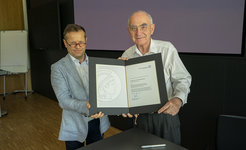Eli Yablonovitch is named MPQ Distinguished Scholar
The U.S. physicists receives the award for his groundbreaking work in the field of photonic crystals and their applications in semiconductor technology.
Last week, Eli Yablonovitch has been named MPQ Distinguished Scholar, which is an award and research scholarship given to outstanding scientists in the field of optics, photonics, quantum physics, or other areas related to quantum optics by the Board of Directors of the Max Planck Institute for Quantum Optics. This program allows an awardee to spend up to six months at the Institute to collaborate with its scientific departments. The decision for a scholarship is based on scientific excellence.

Eli Yablonovitch is Professor in the Graduate School, UCLA & UC Berkeley, Electrical Engineering & Computer Sciences Dept. His research areas include silicon photonics, telecommunications, optical antennas, new forms of photovoltaics as well as the search for a low-voltage replacement for the transistor. His research also encompasses physics-based computing for optimization & deep learning. Recently, he has been investigating physics-based computing approaches to solving hard problems, such as the traveling salesman problem.
Eli Yablonovitch is regarded as a father of the photonic bandgap concept, and he coined the term "photonic crystal". In his photovoltaic research, he introduced the 4n2 (“Yablonovitch Limit”) light-trapping factor, which is in worldwide use for almost all commercial solar panels. His startup company Alta Devices Inc. holds the world record for solar cell efficiency, now 29.1% at 1 sun. He also introduced the idea that strained semiconductor lasers could have superior performance due to reduced valence band (hole) effective mass. With almost every human interaction with the internet, optical telecommunication occurs by strained semiconductor lasers.
„It is my first time at MPQ, and it was a special honor to be recognized as an MPQ Distinguished Scholar. MPQ has world-renowned expertise and equipment in femto-second optical pulses. I am expecting my co-operation with MPQ will be directed toward answering a fundamental question in semiconductor Physics: What is the cause of the Urbach tail of semiconductor band-edges, and what determines its characteristic energy? The Urbach tail is decisive in solar cells, in laser refrigeration, it influences optical fiber transmission, and limits new types of proposed transistors. After many years of study, we don't know why it's present in all the common semiconductors. We believe that when MPQ's time resolution is added to the existing spectral signature of the Urbach tail, then this mystery can be solved“, comments Eli Yablonovitch.
Last year, Kerry Vahala, a pioneer on ultra-high-quality resonators, has received the MPQ Distinguished Scholar certificate based on a nomination from Theodor Hänsch’s laser spectroscopy group, and spent a couple of months at the Institute to collaborate with the group of Nathalie Picqué on frequency microcombs and with Thomas Udem on questions relating to ion traps. The Attosecond Physics group of Ferenc Krausz is already looking forward to their scientific cooperations with Prof. Yablonovitch.












